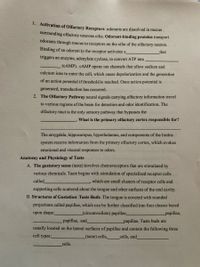
Human Anatomy & Physiology (11th Edition)
11th Edition
ISBN: 9780134580999
Author: Elaine N. Marieb, Katja N. Hoehn
Publisher: PEARSON
expand_more
expand_more
format_list_bulleted
Concept explainers
Question
Fill in blanks

Transcribed Image Text:1. Activation of Olfactory Receptors: odorants are dissolved in mucus
surrounding olfactory neurons cilia. Odorant-binding proteins transport
odorants through mucus to receptors on the cilia of the olfactory neuron.
Binding of an odorant to the receptor activates a
that
triggers an enzyme, adenylate cyclase, to convert ATP into
(CAMP). CAMP opens ion channels that allow sodium and
calcium ions to enter the cell, which cause depolarization and the generation
of an action potential if threshold is reached. Once action potential is
generated, transduction has occurred.
2. The Olfactory Pathway neural signals carrying olfactory information travel
to various regions of the brain for detection and odor identification. The
olfactory tract is the only sensory pathway that bypasses the
What is the primary olfactory cortex responsible for?
The amygdala, hippocampus, hypothalamus, and components of the limbic
system receive information from the primary olfactory cortex, which evokes
emotional and visceral responses to odors.
Anatomy and Physiology of Taste
A. The gustatory sense (taste) involves chemoreceptors that are stimulated by
various chemicals. Taste begins with stimulation of specialized receptor cells
called
which are small clusters of receptor cells and
supporting cells scattered about the tongue and other surfaces of the oral cavity.
B. Structures of Gustation: Taste Buds. The tongue is covered with rounded
projections called papillae, which can be further classified into four classes based
upon shape:
(circumvallate) papillae,
papillae,
papillae, and
papillae. Taste buds are
usually located on the lateral surfaces of papillae and contain the following three
cell types:
(taste) cells,
cells, and
cells.
Expert Solution
This question has been solved!
Explore an expertly crafted, step-by-step solution for a thorough understanding of key concepts.
This is a popular solution
Trending nowThis is a popular solution!
Step by stepSolved in 2 steps

Knowledge Booster
Learn more about
Need a deep-dive on the concept behind this application? Look no further. Learn more about this topic, biology and related others by exploring similar questions and additional content below.Similar questions
- why nature is an artarrow_forwardWhat do you mean by transportation?arrow_forwardThe factory is run by a boss, but he or she rarely comes down to the factory floor. Instead, the boss sits in the office where all the blueprints and designs for the factory products are kept. The boss sends orders to the factory workers on the floor with instructions on what to make next as well as how much to make. The boss's office represents the A. Smooth ER B. Nucleus C. Rough ERarrow_forward
- why it is important for pharmacy to have a door that automatically opens as someone approaches it for the disbility people who use walkers or wheelchairs.?arrow_forwardWhy the environment is an asset to mankindarrow_forwardWhat role can advancements in forensic biology play in the investigation and resolution of criminal cases, and how can this information be effectively presented in court to ensure a fair trial?arrow_forward
arrow_back_ios
SEE MORE QUESTIONS
arrow_forward_ios
Recommended textbooks for you
 Human Anatomy & Physiology (11th Edition)BiologyISBN:9780134580999Author:Elaine N. Marieb, Katja N. HoehnPublisher:PEARSON
Human Anatomy & Physiology (11th Edition)BiologyISBN:9780134580999Author:Elaine N. Marieb, Katja N. HoehnPublisher:PEARSON Biology 2eBiologyISBN:9781947172517Author:Matthew Douglas, Jung Choi, Mary Ann ClarkPublisher:OpenStax
Biology 2eBiologyISBN:9781947172517Author:Matthew Douglas, Jung Choi, Mary Ann ClarkPublisher:OpenStax Anatomy & PhysiologyBiologyISBN:9781259398629Author:McKinley, Michael P., O'loughlin, Valerie Dean, Bidle, Theresa StouterPublisher:Mcgraw Hill Education,
Anatomy & PhysiologyBiologyISBN:9781259398629Author:McKinley, Michael P., O'loughlin, Valerie Dean, Bidle, Theresa StouterPublisher:Mcgraw Hill Education, Molecular Biology of the Cell (Sixth Edition)BiologyISBN:9780815344322Author:Bruce Alberts, Alexander D. Johnson, Julian Lewis, David Morgan, Martin Raff, Keith Roberts, Peter WalterPublisher:W. W. Norton & Company
Molecular Biology of the Cell (Sixth Edition)BiologyISBN:9780815344322Author:Bruce Alberts, Alexander D. Johnson, Julian Lewis, David Morgan, Martin Raff, Keith Roberts, Peter WalterPublisher:W. W. Norton & Company Laboratory Manual For Human Anatomy & PhysiologyBiologyISBN:9781260159363Author:Martin, Terry R., Prentice-craver, CynthiaPublisher:McGraw-Hill Publishing Co.
Laboratory Manual For Human Anatomy & PhysiologyBiologyISBN:9781260159363Author:Martin, Terry R., Prentice-craver, CynthiaPublisher:McGraw-Hill Publishing Co. Inquiry Into Life (16th Edition)BiologyISBN:9781260231700Author:Sylvia S. Mader, Michael WindelspechtPublisher:McGraw Hill Education
Inquiry Into Life (16th Edition)BiologyISBN:9781260231700Author:Sylvia S. Mader, Michael WindelspechtPublisher:McGraw Hill Education

Human Anatomy & Physiology (11th Edition)
Biology
ISBN:9780134580999
Author:Elaine N. Marieb, Katja N. Hoehn
Publisher:PEARSON

Biology 2e
Biology
ISBN:9781947172517
Author:Matthew Douglas, Jung Choi, Mary Ann Clark
Publisher:OpenStax

Anatomy & Physiology
Biology
ISBN:9781259398629
Author:McKinley, Michael P., O'loughlin, Valerie Dean, Bidle, Theresa Stouter
Publisher:Mcgraw Hill Education,

Molecular Biology of the Cell (Sixth Edition)
Biology
ISBN:9780815344322
Author:Bruce Alberts, Alexander D. Johnson, Julian Lewis, David Morgan, Martin Raff, Keith Roberts, Peter Walter
Publisher:W. W. Norton & Company

Laboratory Manual For Human Anatomy & Physiology
Biology
ISBN:9781260159363
Author:Martin, Terry R., Prentice-craver, Cynthia
Publisher:McGraw-Hill Publishing Co.

Inquiry Into Life (16th Edition)
Biology
ISBN:9781260231700
Author:Sylvia S. Mader, Michael Windelspecht
Publisher:McGraw Hill Education